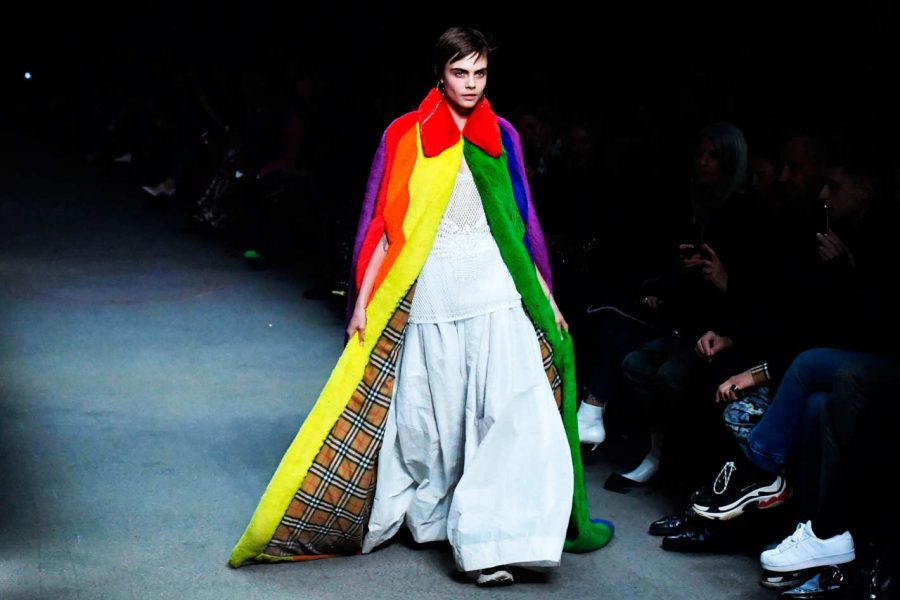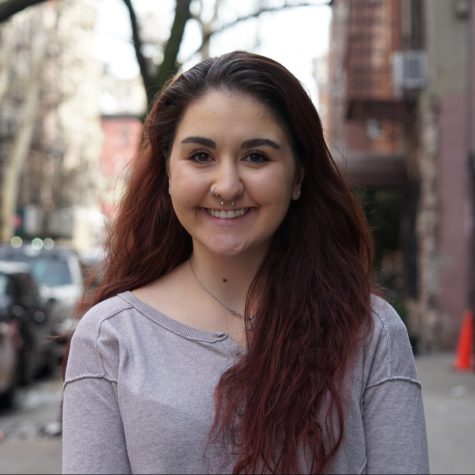London Fashion Week Makes a Splash Across the Pond
Cara Delevingne walking the runway for Burberry’s spring 2018 ready-to-wear collection.
February 26, 2018
As Lady Liberty waved goodbye to the catwalks and designers this past week, Big Ben welcomed them to London with open arms for London Fashion Week. In London, Fashion Week ran from Feb. 15 to 20 and included a wide range of designers and styles. To make sense of all of the runways, WSN summed up the Burberry and Richard Quinn runway shows, which proved to be some of the most influential and memorable shows that fashion had to offer this Fall/Winter 2018 season.
Burberry’s Fall/Winter 2018 show marked the final collection for Chief Creative Officer Christopher Bailey, who rounded out his 17 years at Burberry in style. The show heavily featured a rainbow motif, which was prominent in many designs.
Christiana Patch, a CAS first-year student, enjoyed the bright and bold colors of the rainbows.
“Rainbows are huge in fashion right now,” Patch said. “Color is everything, and I’m here for it.”
Notably, the rainbow pieces of the collection stand as a strong statement of support for LGBTQ rights, utilizing the symbol of the rainbow flag which has long been representative of the community. Patch felt that the colors of the rainbow also signified a broader social implication for fashion.
“As the world becomes more bleak and the political climate is getting darker, fashion is being an outlet of expression to allow for more color and more fun,” Patch said.
The use of vivid rainbow patterns was an unexpected move for Burberry as it’s known for its classic designs and signature plaid. However, this bold statement for the brand reflects Bailey’s vision for his final collection — titled “Time” — which embodied Burberry’s “past, present and future.”
CAS first-year Julia Lailler felt that the collection fulfilled this goal of bridging the gap between Burberry’s past and future.
“I liked how [Bailey] meshed the signature tan plaid, with bright and bold rainbow colors to create this coming together of old and new,” Lailler said.
In addition to Burberry, Richard Quinn’s show also carried significance at London Fashion Week. The designer won the first Queen Elizabeth II Award for British Design for the bold prints he featured in his work. At the show, the Queen presented the award in-person and coincidentally sat beside the queen of fashion: Vogue’s Editor-in-Chief Anna Wintour. This year’s collection included a plethora of floral prints as well as helmets and scarves that covered some models’ faces.
CAS first-year Will Gutierrez felt that the show’s designs were innovative, qualifying Quinn for the award.
“It was well-deserved of the award that it got for the risk that it took,” Gutierrez said.
Patch agreed that the collection was unique and liked the print and silhouette pairings.
“I think [the collection’s] beautiful, and I think the garments are incredibly structured, which is interesting because I feel like typically when you see a floral you think like flowy summer-time,” Patch said.
These two collections will likely have influence for the season ahead, especially as students attempt to take cues from the emerging fashion trends that often spring directly from the runway. Both the Burberry and Richard Quinn shows made an impression on the fashion world and will influence future innovations.
A version of this article appeared in the Monday, Feb. 26 print edition. Email Faith Marnecheck at [email protected].













































































































































